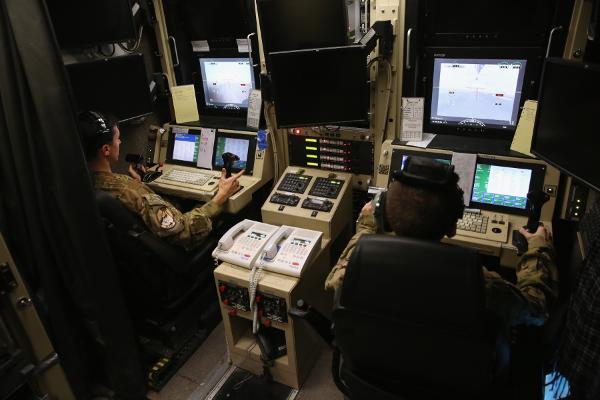 Military Update: Thousands of Air Force personnel in units called Distributed Common Ground Systems (DCGS) daily gather video and audio intelligence on Islamic State fighters in Iraq, Syria and Libya. Identifying and tracking a barbaric enemy can mean witnessing, on occasion, rape or torture or murder of captives or civilians of any age.
Military Update: Thousands of Air Force personnel in units called Distributed Common Ground Systems (DCGS) daily gather video and audio intelligence on Islamic State fighters in Iraq, Syria and Libya. Identifying and tracking a barbaric enemy can mean witnessing, on occasion, rape or torture or murder of captives or civilians of any age.
DCGS data are rapidly collated with other intel to produce targets for pilots flying remotely piloted aircraft (RPAs) armed with Hellfire missiles and GBU-12 laser-guided bombs. Operating around the clock from select commands, pilots and support teams watch in high-definition as enemy targets are destroyed, and the number of deaths and damage assessed.
These warriors fighting through computer consoles in air-conditioned spaces are arguably the most lethal in the Air Force. The Army, Navy and Marine Corps are pressing to acquire similarly effective capabilities.
Shock and Awe: View drone strikes in the Military.com Video Center.
But number of strikes by Air Force drone pilots and DCGS units has exploded in recent years. In 2010, remotely piloted aircraft fired on 243 targets. This year, just through October, strikes totaled 2,473. The final 2016 number will be 12 times the strike total of seven years ago.
The growth, in part, reflects U.S. resolve to help Iraq’s military and local militias wipe out ISIL, the Islamic State of Iraq and the Levant, without committing a large U.S. ground force again to the region. But reliance on remote warriors and high tech sensors also reflect an ongoing revolution.
“It’s the most rapidly evolving, fastest growing mission-set in the entire” Department of Defense, said Col. James McEachen, assistant to the surgeon general for the 25th Air National Guard. The “amazing” pairing of RPAs with DCGS intelligence has “redefined our approach to warfare in ways that are going to be with us for decades to come.”
While demand for the systems is “insatiable” given their “decisive advantage,” McEachen said, pilots and intel airmen face “unique stresses -- occupationally, operationally, behaviorally, even combat-related.”
The stress is significant enough, and recognized both by operators and the medical community, that the Air Force surgeon general has begun to embed mental health teams in remote warrior units to help treat the stress and improve mission performance.
McEachen and two medical colleagues even more deeply involved in studying stress in the remote warrior community shared their observations last week at the annual conference of AMSUS, the Society of Federal Health Professionals, held at National Harbor, Md.
Lt. Col. Cameron “Badger” Thurman, flight surgeon for the 480th Intelligence, Surveillance and Reconnaissance Wing, at Langley Air Force Base, Va., noted that in the last 10 years the Air Force lost 50,000 active duty personnel but its ISR community grew by 35,000.
The 480th, he said, has up to 80 percent of reconnaissance imagery analysts in the entire Air Force. These enlistees are bright, score high on aptitude tests, have had largely sheltered lives of strong family values. Yet and within a year of tracking ISIL, one in 10 analyst will see a rape as it occurs, perhaps incidents of torture and, of course, U.S. missile and bomb strikes that will kill ISIL fighters they’ve helped to identify.
“The President has publicly stated that America’s number one contribution to the fight against ISIL is going to be ISR,” said Thurman. “That means America’s newest conflict has weighed very heavily on the shoulders of the men and women of the 480th ISR wing.”
Pilots flying combat missions in theater or soldiers facing ground threats might question the level of stress experienced by remote warriors. Their lives aren’t at risk, Thurman said.
“However, the decisions and actions they take have direct impact on who lives and who dies on the battlefield. And those men and women are going to see, in full detail near real time, the effects of those decisions on both the enemy, on American forces and even on civilians,” he said.
That their own lives aren’t in danger, Thurman added, “takes away one of the most powerful coping mechanisms men have when they go to war [and kill the enemy]. That is ‘It was him or me.’ ”
“And sometimes,” he said, “it’s not who you kill that keeps you up at night but who you don’t kill.”
Thurman referred to a study showing RPA pilots who didn’t release weapons, after hours watching bad guys misbehave, had a higher rate of emotional exhaustion than pilots who did.
“We all wear the uniform to make a difference. We want to make it better. We want to stop these things,” he said. “Take that personality type and put them in a situation where they’re going to watch ISIL murder a village, or rape somebody, or do the horrible things they do, and that’s a very powerful, negative influence.”
Imagery analysts have watched ISIL use hand drills on teeth and eyes before crucifying victims, forcing locals to watch. The civilian witnesses can make a weapon launch impossible to execute. A skilled analyst, however, can follow the torturer home, perhaps to inform a strike for another day.
The 480th has 6000 personnel operating across six installations with a small medical team embedded in all six, for 1000 operators apiece. Thurman told of one analyst who had watched a hostage taking and gave a rescue team the coordinates. It turned out to be an ISIL trap. Both hostage and rescuers were killed and the analyst emotionally devastated.
The medical team, in that case, asked another analyst to review videotape with the distressed airman to show him he had done okay, and sometimes the enemy effectively employs counterintelligence.
Thurman said imagery analysts can complete two-to-three year assignments in multiple locations over a 20-year career and never leave the 480th wing, or “escape from what some people call ‘Death TV.’ ”
When they experience debilitating stress it’s “really a new form of injury,” Thurman said. Not PTSD but something else.
“Preliminary data show a dose dependent effect. The more times you watch ISIL skin somebody alive, the more times you watch their torture cycle, the more of an impact it has on you.”
Dr. Wayne Chappelle, the surgeon general’s consultant for air medical clinical psychology, has studied stress of RPA pilots and support teams for seven years, and found links both to what they do and how units are organized, with low manning and rotating night-day shifts every 30 days, and administrative burdens often added because they are garrison forces.
When asked what can be done to reduce stress, more manpower is often the response, Chappelle said.
But each kill also can add up, with pilots and analysts feeling both positive and negative effects after each weapon release, until one day they need help, or a break like police departments require after an officer discharges a weapon or sees a particularly gruesome traffic accident.
War can still be a deeply personnel experience from thousands of miles away, said Thurman.
To comment, write Military Update, P.O. Box 231111, Centreville, VA, 20120 or email milupdate@aol.com or twitter: @Military_Update.
# # # #
Tom Philpott has been breaking news for and about military people since 1977. After service in the Coast Guard, and 17 years as a reporter and senior editor with Army Times Publishing Company, Tom launched "Military Update," his syndicated weekly news column, in 1994. "Military Update" features timely news and analysis on issues affecting active duty members, reservists, retirees and their families.
Visit Tom Philpott's Military Update Archive to view his past articles.
Tom also edits a reader reaction column, "Military Forum." The online "home" for both features is Military.com.
 Tom's freelance articles have appeared in numerous magazines including The New Yorker, Reader's Digest and Washingtonian.
Tom's freelance articles have appeared in numerous magazines including The New Yorker, Reader's Digest and Washingtonian.
His critically-acclaimed book, Glory Denied, on the extraordinary ordeal and heroism of Col. Floyd "Jim" Thompson, the longest-held prisoner of war in American history, is available in hardcover and paperback.




